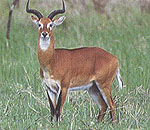UGANDA KOB

How to Recognize
The Uganda kob is considered Uganda’s "national antelope." They are reddish or ochre in color with white markings on the face and throat. They have black on their legs, and females lack the male’s lyre-shaped horns. They are recovering well after Uganda’s civil war.
Habitat
They can be found in river flats and short grasslands, especially those trampled by other grazers or created by fires. They graze on green belts near waterways during the dry season and move to higher grounds during the rainy season.
Behavior
Diurnal and nocturnal. Kobs are gregarious, with bucks usually holding territories some distances apart. Females live in small herds with no apparent hierarchy. Sometimes females form large herds of thousands when in search of water.
Breeding
Calves are born year-around after a eight month gestation, and they remain hidden for six weeks before joining the herd. Kob bucks strut with their heads high and horns pointing back horizontally when trying to attract a doe’s attention.
Mating takes place in "leks" – areas of turf, often enclosed by longer grass – where bucks stake out territories radiating from one or more hubs of accumulated dung or urine-soaked soil. Here the bucks fight all challengers for the right to mate, rarely holding their right for more than a few days and often exhausting themselves within a few hours.
Herds of bachelors wait nearby to fight. The urine attracts both sexes to the leks, and 90% of females enter an area on their day of estrus to mate with a few males that have won their territories.
Feeding
They graze on short grasses cropped by other species, green flushes after fires, and "kob fields."
Enemies
Lions and hyenas. They move in mass when threatened which confuses or intimidates predators. When they are pursued, they seek refuge in water or reed beds.
TOP OF PAGE
Copyright © 2002, Dawn M. Dalton.
All rights reserved.
**LINKS**
WHERE?
WHY?
ITINERARY
PLAN YOUR TRIP
GETTING THERE
LONDON
KENYA
UGANDA
SAFETY
ITEMS BOUGHT
STAYING HEALTHY
COMMENTS
HOME
BHS HOME
---Animal Facts--
Baboon
Buffalo
Cheetah
Chimpanzee
Crocodile
Eland
Elephant
Gazelle
Giant Forest Hog
Giraffe
Gorilla
Hippopotamus
Hyena
Hyrax
Impala
Jackal
Lion
Mongoose
Monkey
Ostrich
Rhinoceros
Topi
Uganda Kob
Warthog
Waterbuck
Wildebeest
Zebra